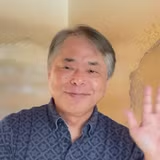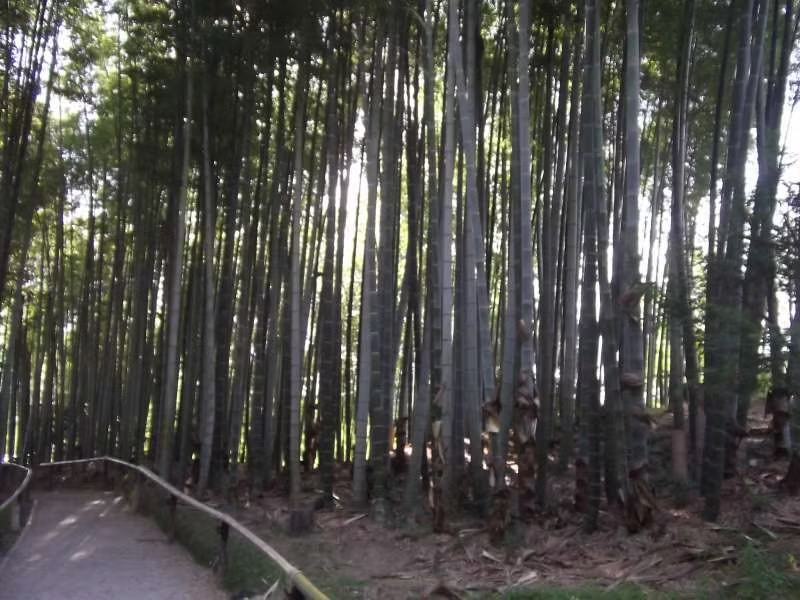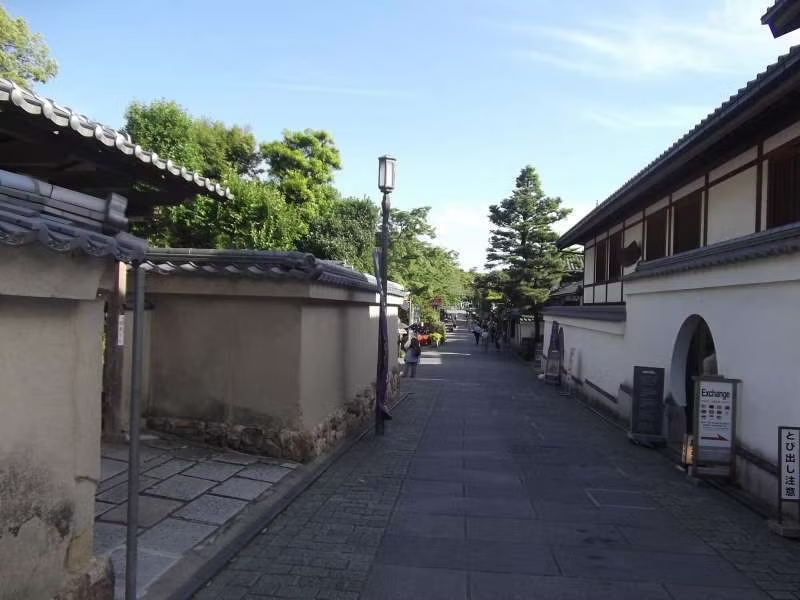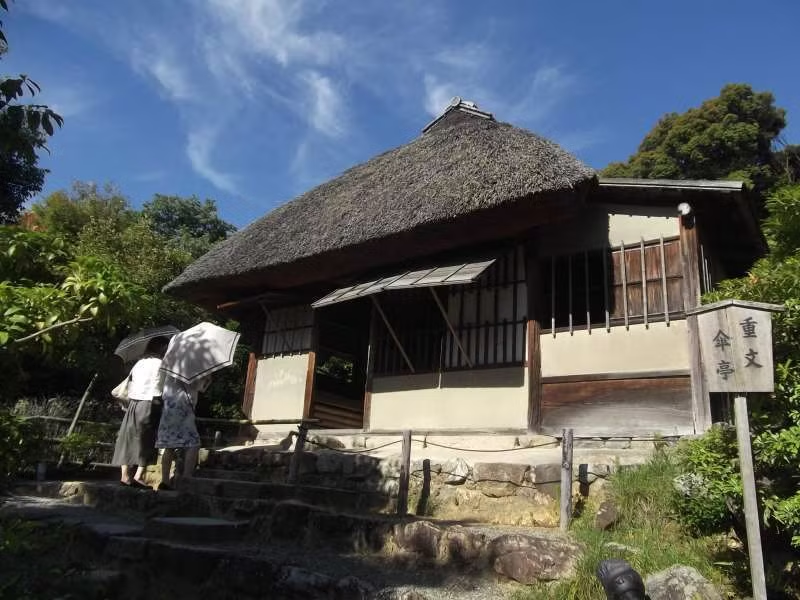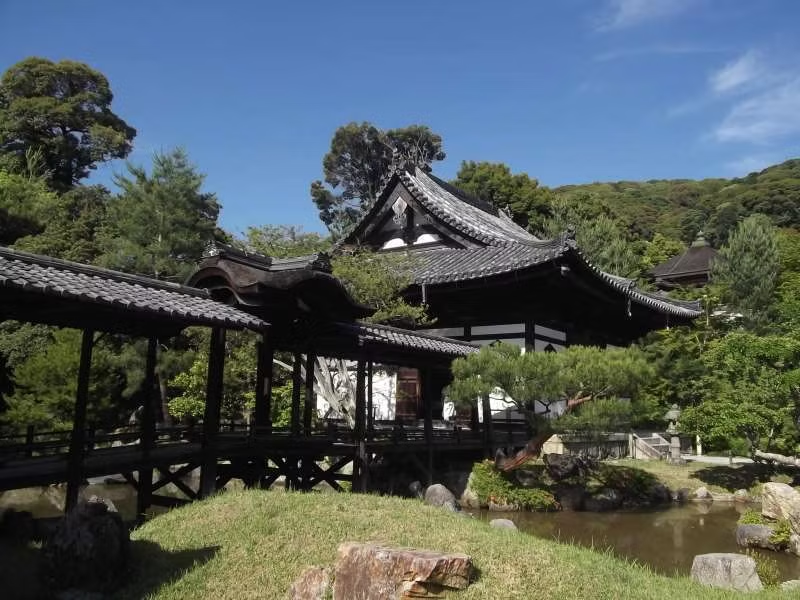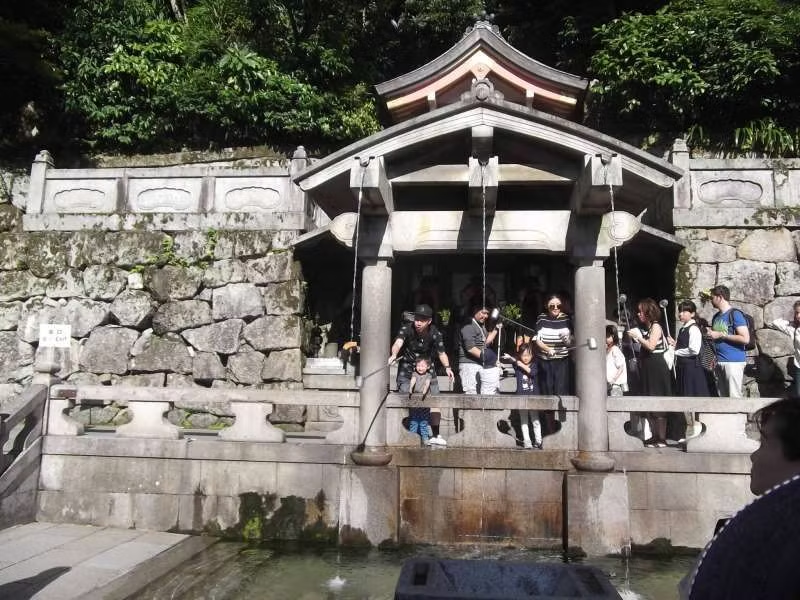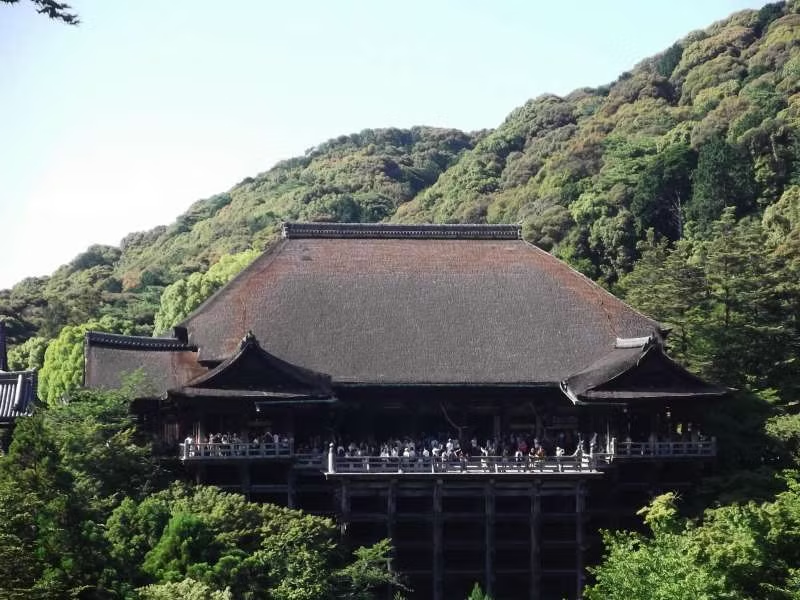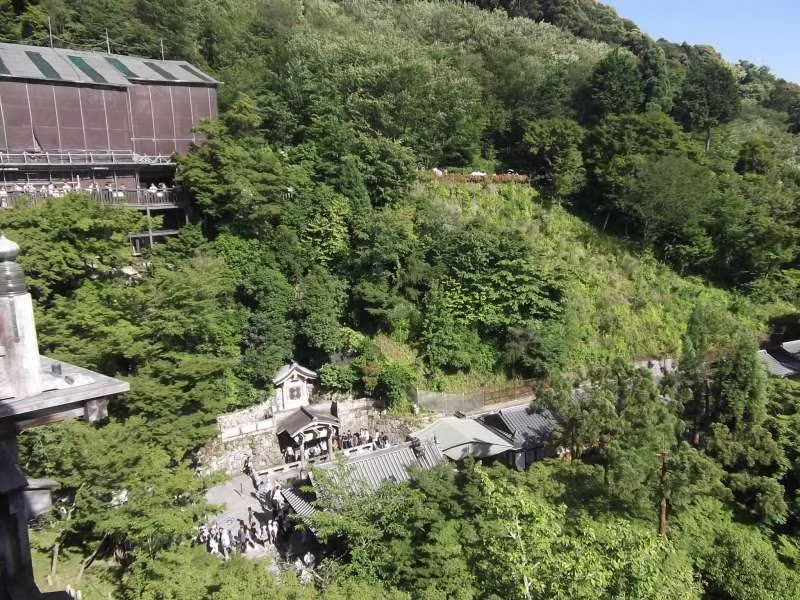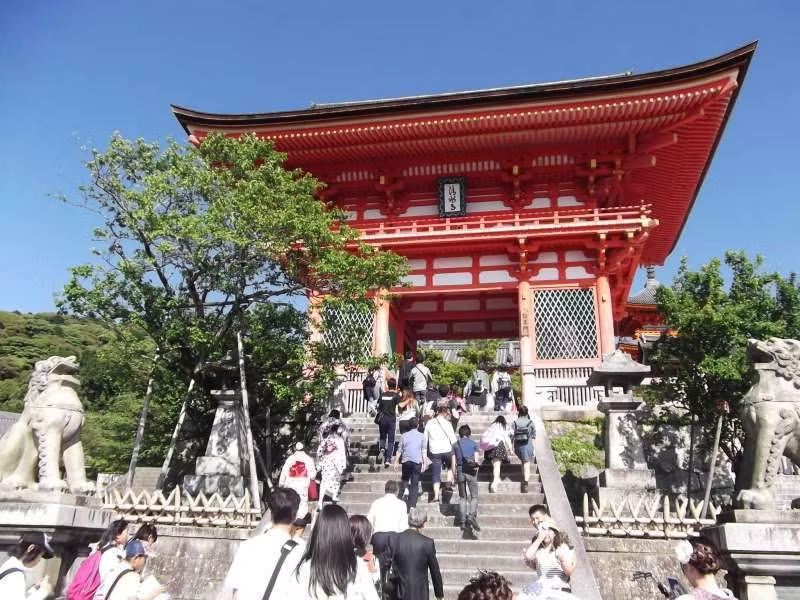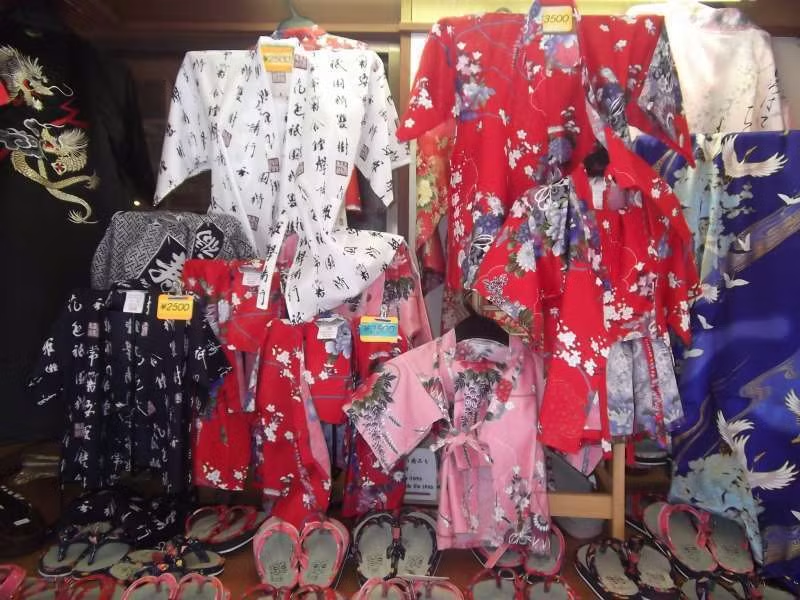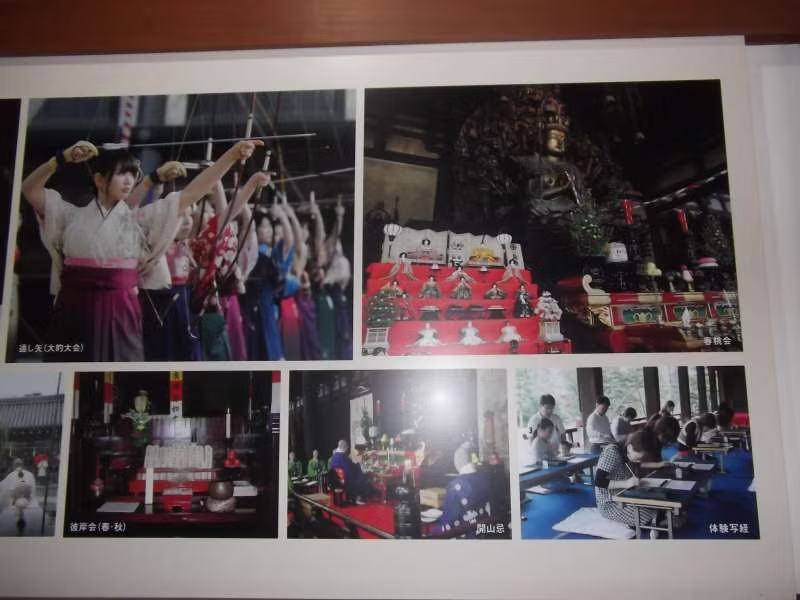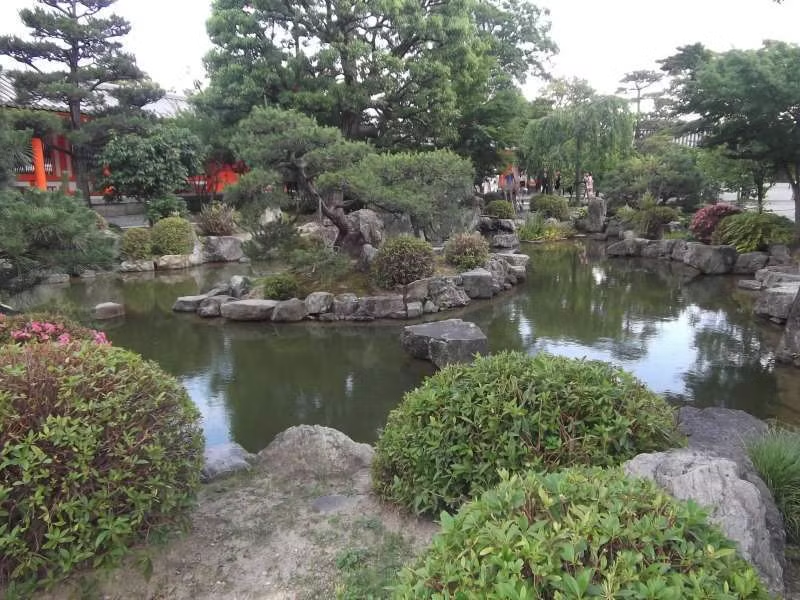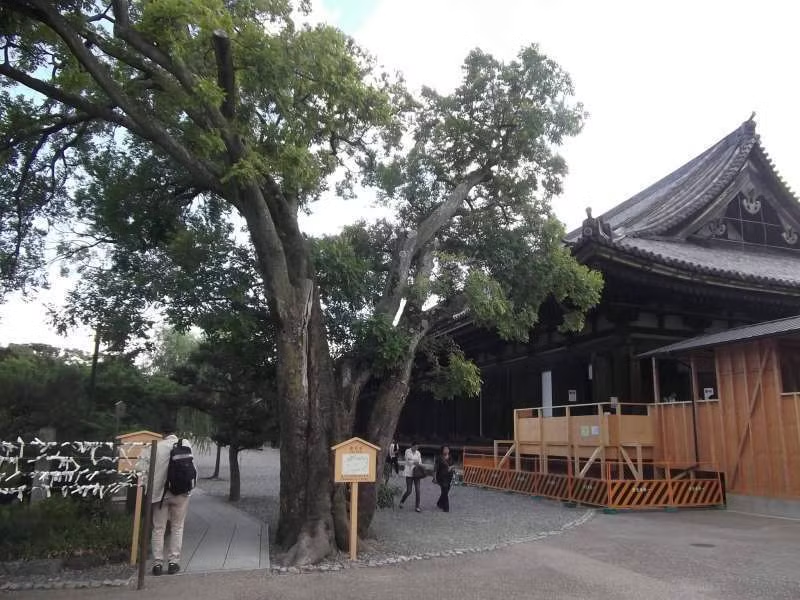Premium tour of Kyoto: (3) Sanjusangendo temple, Kiyomizu-dera temple & Kodaiji temple
(1) Sanjusangen-do temple
Officially called "Rengeo-in", meaning "Temple of the Lotus King Kannon-bosatsu", and designated as the National Treasure, it was originally established by the order of the cloistered emperor in 1164. After the original temple building was burnt down in 1249, the building was reconstructed in 1266 and it has remained unchanged to this day for some 700 years with four major renovations in that period. There is a 335-centimeter-high seated statue of Buddhist deity, Senju-Kannon Sahasra-bhuja, the principal image, and 1,000 life-size standing statues of Senju-Kannon in the 118-meter-long main hall of the temple.
There are also two powerful and dynamic statues of "Fujin" Wind God and "Raijin" Thunder God at either end of the hall and 28 images of guardian deities protecting the 1,001 "Kannon" deities and pious Buddhists. The statues are made of Japanese cypress using the assembled-wood construction method called "yosegi-zukuri" and coated with gold foil. As there are thirty-three 2.5-meter-long spaces between the columns, the temple came to be called "Sanjusangen-do" (a hall with 33 spaces between columns).
They tend to be ignored, but you cannot miss the two structures in the temple precincts: South Gate and roofed earthen fence, both of which are said to be made based on the idea of one time ruler of Japan, Toyotomi Hideyoshi and reflect the aesthetics of the 16th century.
(2) Kiyomizu-dera temple
According to the Chronicle of Kiyomizu-dera temple, it originated in 778 when the noted monk, Enchin, enshrined an image of "Kannon" Goddess of Mercy on the mountain overlooking the Otowa-no-taki waterfall; later in 798, the distinguished general, Sakanoue-no-Tamuramaro, built a Buddha hall there, following which the temple came under the official patronage of Emperor Kammu. Repeatedly destroyed by fire over the centuries, it was rebuilt on each occasion.
Today, the principal temple buildings are the "Saimon" West Gate, the three-storied pagoda, the "Kyodo" Sutra Hall, the "Tamurado" Founder`s Hall, the "Todorokimon" Middle Gate, the "Asakurado" Hall, the "Hondo" Main Hall and the "Amidado" Amida Buddha Hall, all aligned on an east-west axis.
The "Hondo" Main Hall, built in 1633, is the central building of the temple compound and is an example of "Kake-zukuri", or "overhang" architecture. It is famous for its so-called "Kiyomozu-dera stage", an imposing veranda, supported by a forest of tall wooden columns with wooden braces running through them crosswise and lengthwise. The temple itself is a magnificent building utilizing every sophisticated construction technique available in the olden times of Japan.
Not only can you be in the solemn atmosphere accompanied by the delicate aroma of burning incense, but also get the breathtaking view below from the 12-meter-high platform, which is popularly known for the proverb "Jumping off the stage of Kiyomizu-dera temple", meaning making a bold attempt at doing something dangerous or impossible. The Buddhist temple is attractive throughout the year in the beautiful natural surroundings: cherry-blossoms in early April, fresh green leaves in early summer and trees with beautiful red and yellow leaves late in autumn. Meanwhile, you can drink cold, clean water from a waterfall below the platform. You can also find various kinds of souvenir shops on both sides of the approach to the temple and spend a happy time there wondering what to buy.
(3) Ryozen-Kannon Goddess & Kodaiji temple
This imposing, 24-meter-high "Kannon" statue built in 1955 to wish for the construction of peace-loving Japan and to console the souls of Japanese killed in World War Ⅱ stands with the rich greenery in the background. Her serene, mild, gentle face gives us relief from our daily worries and concerns.
Kodaiji temple near the Kannon image was built by the wife of Toyotomi Hideyoshi, one-time ruler of Japan, to console his soul in 1606. Later, with the huge financial assistance made by Tokugawa Ieyasu, his successor, the temple enjoyed prosperity. After 1789, however, it lost many of its buildings due to repeated fires except the main hall, the mausoleum of Toyotomi Hideyoshi and his wife Nene called "Mitamaya", where the statues of the couple is seated, the two tea houses and a few other structures.
There is a small museum in the temple precincts called Kodaiji Sho (palm-of-the-hand) Museum, where many pieces of "makie" lacquerware and other artifacts are on display. The lacquerware was made by sprinkling gold powder on the lacquered products such as spice containers, pitchers and chests of drawers. They are associated with the life of the wife of Toyotomi Hideyoshi.
Itinerary
This itinerary can be customized to meet your needs and preferences. Send me a message with your requests!
Meeting Point
At your hotel
Sanjusangen-do temple
Kiyomizu-dera temple stage
Ryozen Kannon statue
Kodaiji-temple
Ending Point
At your hotel
Want to personalize this tour?
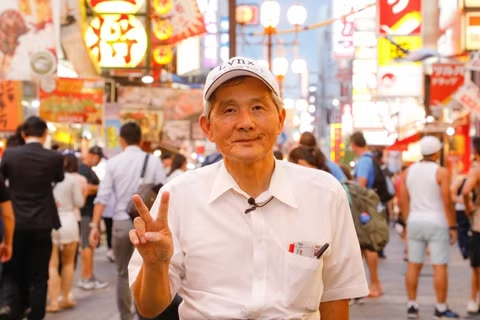
This tour can be customized to meet your needs and preferences. Click below to send me a message with your requests.
Inclusions & Exclusions
guide fee, hotel pick-up in Kyoto area.
transportation fee (you and guide), lunch, dinner, entrance fee, hotel pick-up outside Kyoto area
Tour Important Information
Important message from the supplier
I would like at least 7 days notice before a booking.
Cancellation Policy
- Free cancellation - 8 days prior to meeting time
- 50% Refund - 3 to 7 days prior to meeting time
- No Refund - Within 2 day(s) prior to meeting time
About Tour Guide Tatsuhiro N.
It took me some 20 years to be qualified for this job and I feel honored for being able to help tourists from abroad understand our nation and culture. Japan is a beautiful country with a long history, tradition and rich cultural heritages, having various features in each of the four distinct seasons. Although there are now many visitors from abroad, mainly from Asian countries, they are mostly interested in shopping taking advantage of cheaper yen rather than understanding our people and culture. Kyoto and Nara are the two cities best known by foreign tourists, but not all the aspects of Japanese culture are concentrated there. If you visit the countryside other than these two cities, you will never fail to see the beautiful natural surroundings and people who will warmly welcome you. I wish to work as the bridge between Japanese people and tourists from all over the world.
Reviews
Susanne U.
“Great day lovely experience”
What a great day and lovely experience we had in Kyoto. Hiro-san was very helpful and kind and showed us all sopts we wanted to see. He explained a lot about history and also brought some props with him to dress up for photos which our daughter loved. He was also very helpful guiding us through public transportation which helped us a lot during the rest of our stay in Kyoto. Thank you Hiro-san for this beautiful experience.

Tatsuhiro N.
Hi Susanne-san, Danke. Thank you very much for your favorable comment. There can be no greater honor for me as a guide than to have such a lavish praise. I wish you all a good health and happiness in the days ahead. Especially, a healthy growth for Heidi. Auf Wiedersehen. Regards, Hiro
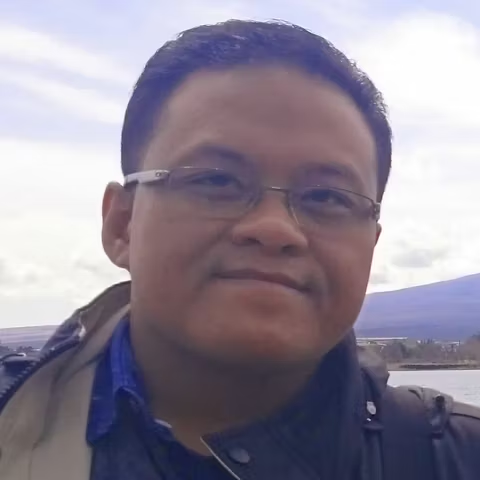
Anangga P.
“Superb Guide in Amano-hashidate from Tatsuhiro-san”
I was so worried leaving my elderly mother and aunts alone touring Amano-hashidate, especially since one of my aunts has just got her knee operated so she needs to be in wheelchair. Thankfully Tatsuhiro-san is there and went well and beyond his task as a guide by also taking care my family while showing the beauty of one of Japanese's often missed scenic spot. Tatsuhiro-san also tried his best to show the elderly entourage the area albeit he himself is not from around it. Alas, the weather is not so favorable this time so we got our Ine-Bay boat trip cancelled by the organizer, but thanks to Tatsuhiro-san's effort and kindness, my mother and aunts came back to the hotel full of smiles. Thank you so much, Tatsuhiro-san!

Tatsuhiro N.
Hi Anannga-san, "Dou-itashimashite", meaning no problem at all. I am really glad the tour was completed safely and that your mom and aunts were in full smiles. I am just happy for it. I wish the earliest possible recovery from her knee operation for one of your aunts (sorry, I forgot her name) and the happy life in the days ahead for all of them. Thanks again for the wonderful souvenir and the full mark for me. Good luck. Regards, Hiro
David J.
“Kyoto tour tailored to our needs ”
Our cruise ship was docked in Kobe, and Hiro willingly adjusted his tour to fit in with our need to return to Kobe before the ship sailed away. He met us at Kyoto Station, and returned us there in good time for our return Shinskansen to Kobe. Despite having less time we still had plenty of time to enjoy Kyoto Castle and Kinkakuji Golden pavilion.

Tatsuhiro N.
Hi David-san, Thank you very much for giving me the high grade. I am glad if you could have had a glimpse of our history in the turbulent years and of the beautiful structure. I wish you a happiness and a good health in the years ahead. Regards, Hiro
$211/ per group
More tours by Tatsuhiro N.
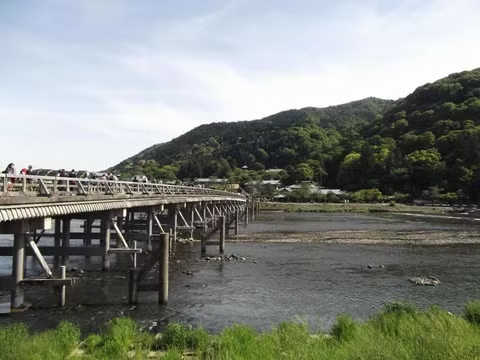
Premium tour of Kyoto (1) : Arashiyama, Nijo-jo Castle & Kinkakuji temple
Why not enjoy your holidays in Kyoto? You can certainly get in touch with many things Japanese that we are proud of. They are old temples and shrines, cultural assets and the beautiful natural surroundings. You can also enjoy dropping in at souvenir stores and buy exquisitely made products, such as folding fans, porcelain and traditional Japanese cakes. I would like to take you to the following places, which are the three representative tourist destinations in this city: (1) Arashiyama It is the place where all the traditional natural beauties of Japan are combined together. They are Togetsukyo bridge, bamboo grove and the old temples. If you go up to the observation spot, you can enjoy the magnificent view of the gorge below. You can also see rickshaws of the olden times drawn by young people with smiling passengers on board. There are souvenir shops selling variety of goods and products. (2) Nijo-jo Castle (World Cultural Heritage Site) This castle was built in the early 17th century by the Tokugawa Shogunate government for the purpose of protecting the Kyoto Imperial Palace and as the accommodations when Tokugawa Shogun was in Kyoto. It was subsequently enlarged by successive Shogun. It is the castle as well as the palace, where you can see the powerful structures and beautiful gardens. You can learn, in addition, how great the power of Tokugawa Shogun was. (3) Kinkakuji temple (the Golden Pavilion) (World Cultural Heritage Site) The history of this temple began when the third Shogun of the Muromachi period acquired a tract of land in this area from a powerful statesman in 1397 and built a villa of his own to entertain the Emperor and members of the nobility. The upper two levels of the temple are covered with pieces of gold foil and are shining brilliantly against the background of the rich greenery. The pond in the foreground reflects the golden structure. It looks like the materialization of Pure Land of Buddha in this world. In addition, on the top of the golden structure is the shining phoenix.
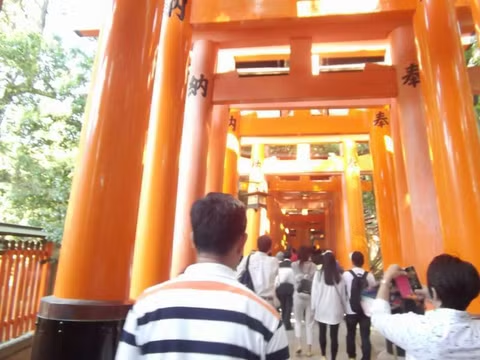
Premium tour of Kyoto (4): Fushimi-Inari-Taisha shrine, Tofukuji temple & Toji temple
Besides the scenic beauty, you can learn the architectural difference between a shrine and a temple in this tour. (1) Fushimi-Inari-Taisha shrine According to the legend, Fushimi-Inari-Taisha shrine was founded when God Inari was enshrined on Mt. Inariyama in February, 711. It celebrated the 1300th anniversary of the God`s enshrinement and all the buildings in the ground were restored and re-painted with the vermilion color in 2011. This shrine is the "So-honzan" head shrine of 30,000 Inari shrines across the country. There are paths called "sen-bon-torii", meaning alleys of tunnels made of 1,000 "torii" gates. Actually, however, it is said there are a total of more than 10, 000 "torii" gates, large and small, in the shrine compound which includes the whole of Mt. Inariyama. You can reach the top of the 233-meter-high mountain, or rather a hill, in about a 1.5-hour walk amid the rich greenery. It is the guardian shrine of merchants and tradesmen, attracting millions of visitors in the New-Year period. Pairs of foxes sitting at the base of "torii" gates are regarded as the messenger of the God. After getting off the train, walk a bit and go through the huge "torii" gate, walk further on the paved main road and you will be met by the huge shrine building. Then, walk along the unpaved narrow paths which are inside the tunnel of "torii" gates according to the instructions of the signboards. There are many vermilion-colored buildings on your way, souvenir shops and small stalls selling charms. You can sit on the sides of the paths and enjoy chatting with your companions or have snacks. There are some places which command a fine view of the city of Kyoto below. (2) Tofukuji temple Established during the Kamakura period (1192 to 1333) of Japan, the name of this Zen Buddhist temple was derived from the two major temples in Nara: Todaiji temple and Kofukuji temple. There are many buildings in the temple precincts, but particularly notable are the three structures. They are: "Hondo" Main Hall, which is open to the public only in the three-day period of March 14, 15 and 16 each year, displaying the left hand of the Great Buddha; Tsutenkyo Bridge, where you can see thick leaves of trees on both sides, leading to Kaisendo Hall, where you can enjoy the atmosphere of the beautiful landscaped garden with a pond and a sand garden; and "Hojo" Hall, which is surrounded by the four representative Zen gardens consisting of rocks and sand. (3) Toji-temple Having the status as the World Cultural Heritage Site, the construction of this temple got started toward the end of the eighth century after the capital of Japan was moved to Kyoto from Nara. After having studied in China for two years, the Venerable "Kobo-Daishi", or "Kukai", was given this temple in 823. He wished that the peace of the nation will be maintained through the teachings of Buddhism whose light reaches every corner of the world and that individual thought will coexist without infringing on each other through the cooperation of all the people. The four main structures of this temple, namely, "Kondo", "Kodo", "Jikido" halls and the 55-meter-high five-storied pagoda were destroyed by typhoons, fires, lightnings and other natural disasters many times since their coming into being in the early 9th century. The reconstruction of these buildings as they stand now were completed in the period between 1492 and 1644. On the 21st of each month, which is called "Kobo-san" and is the monthly return of the date of the demise of the Venerable "Kobo-daishi ", more than 1,000 stalls are installed where you can buy various kinds of antiques and souvenirs. There are more than 200,000 visitors on this day alone. There are 21 Buddhist statues in the" Kodo" Hall, 15 in "Kondo" Hall and many others in the five-storied pagoda, whose door is opened only on that memorable day each month.

Premium tour of Kyoto (2):Nishi-Honganji temple, Higashi-Honganji temple & Shoseien garden
I will take you to the tour of two well-known temples and a quiet garden in Kyoto, all of which located within the radius of one kilometer from JR Kyoto station and provided with the city bus services. (1) Nishi-Honganji temple Designated as the UNESCO World Cultural Heritage Site in 1994, Nishi-Honganji Temple is the mother temple and headquarters of the Honganji faction of Jodo (Pure Land) Shinshu sect of Buddhism. The Jodo-Shinshu teaching was established by the Venerable "Shinran-shonin" (1173-1263) in the Kamakura period (1185 to 1333). He underwent austere training and hardships in various parts of the country before returning to Kyoto to complete his work, "Kyogyoshinsho", or The True teaching, Practice and Realization of the Pure Land Way on Buddhism. After his demise, his daughter erected a mausoleum at Higashiyama, Kyoto, which became the foundation of Nishi-Honganji Temple today. In the 16th century, it was moved to and re-established at the present location. Followers of this sect, according to its doctrine, will be reborn in the Pure Land and attain Enlightenment. They will be able to live lives to the fullest, become aware of both potentials and limitations in this world, overcome difficulties and realize happiness within their lifetime. There are many structures in the precincts, many of which have the status of National Treasures and Important Cultural Properties of Japan. They are: " Amidado" (Hall of "Amida" Buddha, built in 1760), "Goeido" (Founder`s Hall, completed in 1636), "Karamon" Gate, Shoin Hall, "Hiunkaku" House (believed to be part of Jurakudai Palace built by a ruler of Japan, Toyotomi Hideyoshi) and others. There is also a 400-year-old huge ginkgo tree called the "upside-down ginkgo tree", because it looks as if its roots were spread into the sky. (2) Higashi-Honganji temple Originally built in 1604 but most recently rebuilt in 1895, this temple is officially called "Shinshu-Honbyo", or The Principal Mausoleum of the True Pure Land Teaching, consisting of the two gigantic halls of "Goeido", or the Founder`s Hall and "Amidado", or Amida Buddha Hall. This temple belongs to the same faction as its counterpart, Nishi-Honganji temple, so the doctrine is basically the same. However, what makes this temple distinguishable are the historical relics preserved there: "kezuna" hair rope consisting of women`s hair and hemp tissues, a sample of a sledge used to transport huge pieces of timber and the diorama reproducing the scene of the avalanche. There are a total of 156 huge pillars whose diameter is some 60 centimeters made of zelkova tree in the two halls. Important Buddhist ceremonies are occasionally held here, attracting a large number of followers. (3) Shoseien Garden Located some 500 meters east of and belonging to Higashi-Honganji temple, Shoseien Garden has been the place for the retired head priests of the temple to spend their latter days since the middle of the 17th century. There are many gardens, tea houses, along with the two ponds, but the present buildings were rebuilt after the civil war of 1864. After the Meiji Restoration of Japan took place in 1868, many dignitaries, including the consuls of Qing dynasty, Italy and Russia, as well as the Japanese nobles visited there. Even Japanese Emperor Meiji and Russian Crown Prince Nicholas Ⅱ spent some time there. You can enjoy strolling along the paths in the perfectly landscaped garden while watching the trees and hearing birds sing. You can immerse yourself in the quiet and serene atmosphere somewhat different from that of temples.
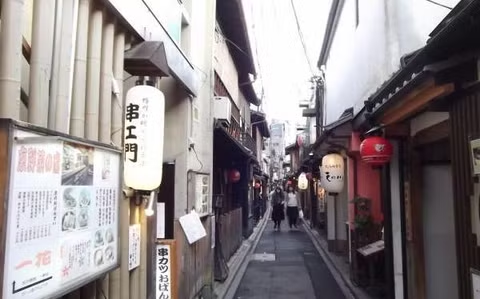
Tour of Gion
(Highlights) Located in the north-east of JR Kyoto station, Gion district is where entertainment facilities and natural beauties are combined: banks on both sides of Kamogawa river where you can spend time sitting, chatting and cooling down, roads on the sides of a smaller river where you can enjoy a leisurely stroll, a whole variety of restaurants and eateries on both sides of "Ponto-cho" alley about three meters in width, shops on the sidewalks of the main road where various items of goods are on display and Yasaka shrine in the eastern end, and so on. The area bustles with people, constituting a striking contrast to the northern areas of the city where many temples and shrines serenely stand. (How to enjoy) Walking along the narrow roads, sidewalks of the main road and banks of Kamo-gawa river will give you a great enjoyment, both physically and spiritually. In particular, you will be amazed at the countless variety of restaurants along the narrow path of "Ponto-cho" district, where you will never miss your favorite food. You can also enjoy seeing "Kamogawa-odori" dance in the theater in that area. There is a huge variety of souvenir shops selling goods representing the traditional Japanese culture. The "Gion Festival " held in July is a spectacular event which you should not miss. There is "Nishiki-ichiba" shopping street nearby, where hundreds of shops selling food items stand. (Others) You can go to Gion by bus for a fare of 230 yen.
Other Popular Highlights Tours in Kyoto
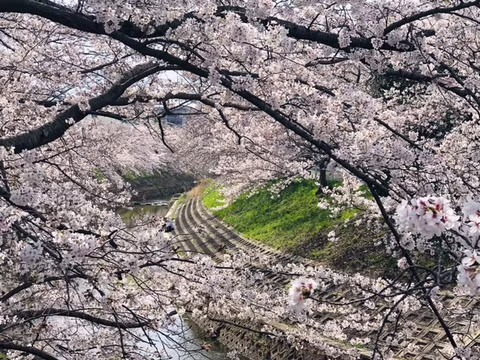
One day tour in Kyoto (Arashiyama area)
Tour will start from the Hotel in Kyoto. Frst visit is Kinkakuji temple (Golden Pavillion ),then, to Ryoanji tmple where is famous for rock garden. Tour will stop at Arasiyama area to take lunch and visit Togetsu bridge, Bamboo grove, Tentyuji temple and others. The last visit is NIjyo castle. As these places are normally crowded. using chartered taxi is highly recommended in order to effectively use your valuable time in Kyoto.
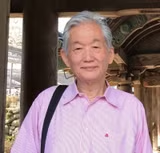
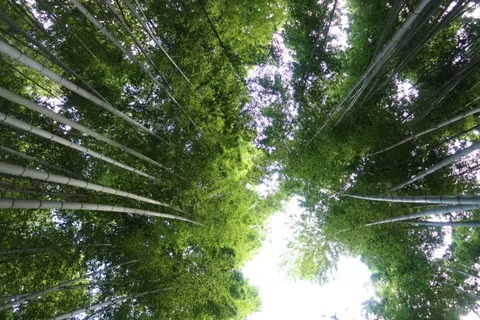
Early Bird Tour Western Kyoto including Bamboo Forest and Kinkakuji Kinkakuji
Shall we explore some of the most popular sightseeing destinations in Kyoto while most tourists are preparing for their tour? I would also like to take you some hidden gemes in Kyoto. Beat the crowds!

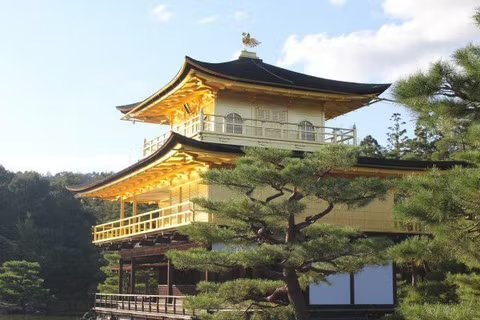
Kyoto's most popular sightseeing spots tour and enjoy a various kinds of Kyoto's specialities
This tour covers 4 must-see sites and Nishiki Market. You visit the most renowned sites such as the Golden Pavilion, Ryo-an-ji temple where you may find an elegant beauty in its simple rock garden Nijo-castle ,the luxurious palace of the Tokugawa Shoguns. Sanjyu-sangendo temple, where the thousand life-size statues and the Principal statue make you feel like you are in a forest of Buddha! says " It's amazing ! Lastly visit Nishiki Market, where you can enjoy eating Kyoto’s cuisine.

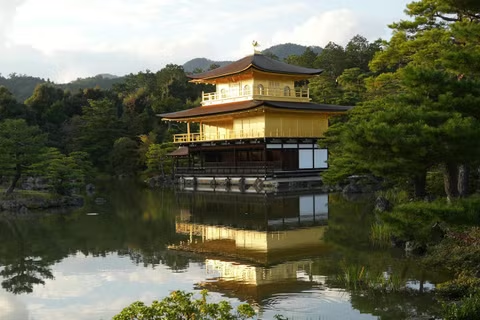
Bamboo grove and Arashiyama area, three World Heritages.
Arashiyama is the hottest tourist destination. It is incredibly beautiful in spring and fall because of its cherry blossoms and autumn leaves. In the fall, the leaves turn brown or red! In the outstanding Tenryuji, you will see a beautiful garden with beautiful mountains in the background. There are many other beautiful places with touching stories in this area. On the way back to downtown, we can visit two world heritage sites, Kinkakuji and Ryoanji. What a wonderful route!
